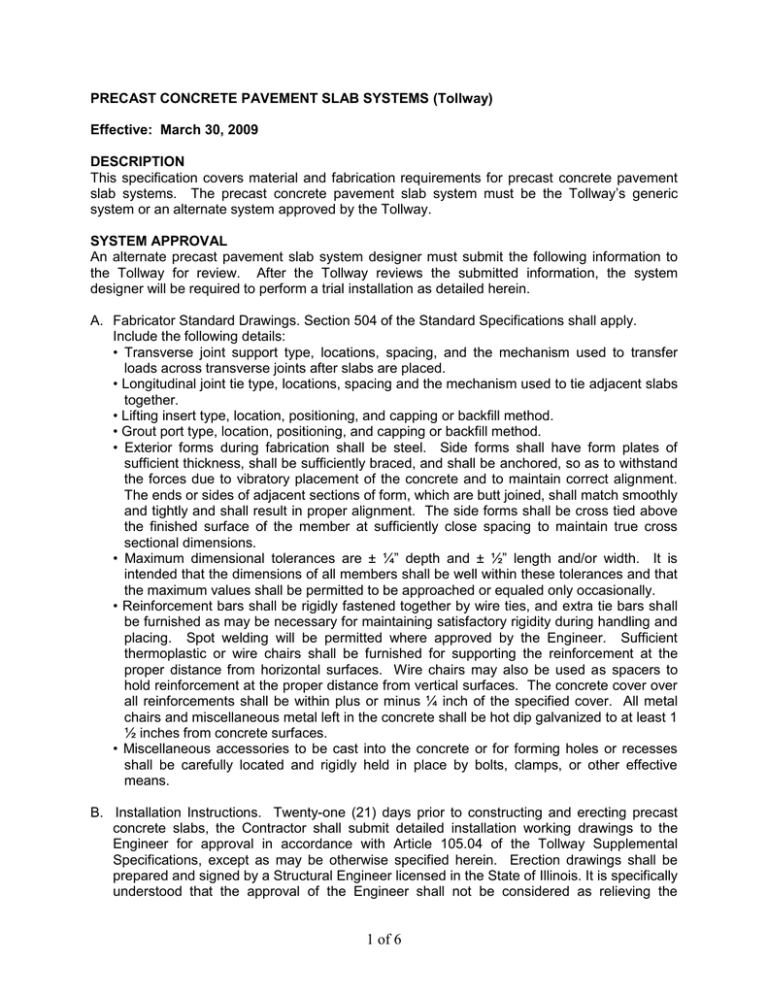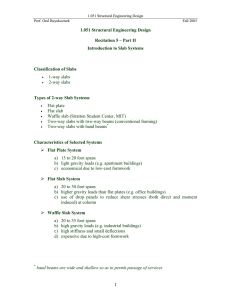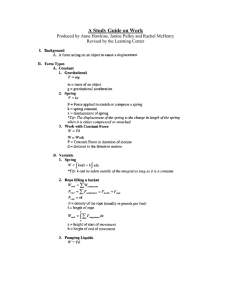CONSTRUCTION OF PRECAST CONCRETE PAVEMENT SLAB
advertisement

PRECAST CONCRETE PAVEMENT SLAB SYSTEMS (Tollway) Effective: March 30, 2009 DESCRIPTION This specification covers material and fabrication requirements for precast concrete pavement slab systems. The precast concrete pavement slab system must be the Tollway’s generic system or an alternate system approved by the Tollway. SYSTEM APPROVAL An alternate precast pavement slab system designer must submit the following information to the Tollway for review. After the Tollway reviews the submitted information, the system designer will be required to perform a trial installation as detailed herein. A. Fabricator Standard Drawings. Section 504 of the Standard Specifications shall apply. Include the following details: • Transverse joint support type, locations, spacing, and the mechanism used to transfer loads across transverse joints after slabs are placed. • Longitudinal joint tie type, locations, spacing and the mechanism used to tie adjacent slabs together. • Lifting insert type, location, positioning, and capping or backfill method. • Grout port type, location, positioning, and capping or backfill method. • Exterior forms during fabrication shall be steel. Side forms shall have form plates of sufficient thickness, shall be sufficiently braced, and shall be anchored, so as to withstand the forces due to vibratory placement of the concrete and to maintain correct alignment. The ends or sides of adjacent sections of form, which are butt joined, shall match smoothly and tightly and shall result in proper alignment. The side forms shall be cross tied above the finished surface of the member at sufficiently close spacing to maintain true cross sectional dimensions. • Maximum dimensional tolerances are ± ¼” depth and ± ½” length and/or width. It is intended that the dimensions of all members shall be well within these tolerances and that the maximum values shall be permitted to be approached or equaled only occasionally. • Reinforcement bars shall be rigidly fastened together by wire ties, and extra tie bars shall be furnished as may be necessary for maintaining satisfactory rigidity during handling and placing. Spot welding will be permitted where approved by the Engineer. Sufficient thermoplastic or wire chairs shall be furnished for supporting the reinforcement at the proper distance from horizontal surfaces. Wire chairs may also be used as spacers to hold reinforcement at the proper distance from vertical surfaces. The concrete cover over all reinforcements shall be within plus or minus ¼ inch of the specified cover. All metal chairs and miscellaneous metal left in the concrete shall be hot dip galvanized to at least 1 ½ inches from concrete surfaces. • Miscellaneous accessories to be cast into the concrete or for forming holes or recesses shall be carefully located and rigidly held in place by bolts, clamps, or other effective means. B. Installation Instructions. Twenty-one (21) days prior to constructing and erecting precast concrete slabs, the Contractor shall submit detailed installation working drawings to the Engineer for approval in accordance with Article 105.04 of the Tollway Supplemental Specifications, except as may be otherwise specified herein. Erection drawings shall be prepared and signed by a Structural Engineer licensed in the State of Illinois. It is specifically understood that the approval of the Engineer shall not be considered as relieving the 1 of 6 Contractor of either responsibility for the safety method and equipment, or responsibility from carrying out the work in full accordance with the Plans and Specifications. Provide installation instructions, including any special equipment and materials to address the following: 1. Removal and Subbase Preparation. Specific procedures for sawcutting and removal if needed and instructions for any recommended subbase preparation. 2. Slab Installation. Instructions, methods, and equipment for lifting, moving, protecting, lowering, and adjusting the slabs into position. 3. Bed and Level Slabs. Instructions to ensure slabs are fully supported by underlying layers at the correct line, grade, and cross slope while meeting contract smoothness requirements. Slabs may be either: • Placed on a precisely graded bedding layer and grouted in-place to fill any small, isolated voids between the slabs and bedding layer (grade-supported). • Placed at final position on flowable fill material, or placed or held near final position and jacked into place (grout-supported). • Placed by other methods approved by the Tollway Materials Manager. For grade-supported slabs, include all pertinent bedding and leveling instructions, including: • Bedding material composition and gradation. • Bedding grout mix design and anticipated strength gain. Bedding grouts must develop a minimum compressive strength of 575 psi in 12 hours. • Method used to place the bedding material and grout beneath the slab. • Method used to ensure complete bedding when placed. For grout-supported slabs, include all pertinent bedding and leveling instructions, including: • Material properties, composition, mix design, and anticipated strength gain of any slab-jacking or flowable fill material. • Method used to place the flowable fill before slab installation or place the slabjacking material beneath the slab after installation. • Method used to ensure complete slab contact with jacking material when placed. 4. Backfilling Pavement Hardware. Instructions to completely encase load transfer tie devices, longitudinal joint ties, lifting inserts, and grout ports. Include all pertinent information, including: • Material properties, composition, mix design, and anticipated strength gain of any backfill material that is not named in Backfill Material for Pavement Hardware, or, revised instructions for those materials if the manufacturer’s instructions are not followed. • Method used to place backfill material. • Method used to ensure complete hardware encasement. 5. Joint Sealing. Instructions, methods, and equipment for filling all joints with hot poured sealant. Subsequent to system approval, any change to approved installation instructions must be submitted to, and approved by, the Tollway. The Tollway reserves the right to require additional trial installations if the changes are deemed significant. C. Trial Installation. Perform a trial installation at a location agreeable to the Tollway. Ensure Tollway personnel are present. Place 4 (minimum) 12 foot x 12 foot slabs simulating 2 lanes of 2 of 6 traffic. Provide a drill rig, with operator, capable of retrieving 4-inch mm diameter cores through any portion of the slab, and a technician capable of fabricating test specimens in accordance with AASHTO T106. As a minimum, the following will be evaluated: 1. Bedding Grout Properties and Completeness of Placement. Fabricate 24 cubes meeting AASHTO T106. 2. Leveling Material Properties and Completeness of Placement. Fabricate 24 cubes meeting AASHTO T106. 3. Backfill Material Properties and Completeness of Placement. If a material identified in this specification as Backfill Material for Pavement Hardware (under Material Requirements) is used in accordance with the manufacturer’s written instructions, no further material testing is required. If a different material is used (or if a material is not used in accordance with the manufacturer’s instructions), fabricate a sufficient amount of test specimens to determine the properties identified in Section C of the Backfill Material Requirements for either mortar or polymer materials as required by the manufacturer, when tested in accordance with AASHTO T106 or the referenced ASTM Standard. 4. Dimensions and Tolerances. Slabs must conform to the Fabricator Standard Drawings and be capable of being placed in an essentially true plane. 5. Instruction Completeness. Manufacturer’s instructions must accurately reflect the processes used in the trial installation. 6. Load Transfer Efficiency (LTE). The Tollway reserves the right to conduct falling weight deflectometer testing to determine LTE at the joints. Poor LTE (≤ 70 %) is cause for rejection. MATERIAL REQUIREMENTS Section 504 of the Standard Specifications shall apply, except as noted herein. A. Concrete. The concrete shall be a Class PC according to Section 1020, and shall have a minimum compressive strength of 4500 psi at 28 days. B. Reinforcement. Article 1006.10 shall apply. Reinforcement shall be epoxy coated. Provide 2-inch (minimum) concrete cover between the mat and the slab bottom. Fabricate mats using a size and spacing of steel (in both directions) that results in a steel area to crosssectional area ratio of 0.002 (minimum). Maximum bar spacing is 18 inches. The manufacturer may provide additional reinforcement based on jobsite loading conditions. (A typical example is when slabs must be loaded before a bedding grout is placed.) C. Backfill Material for Pavement Hardware. If the precast slab system requires a backfill material around pavement hardware or tie device, use DBR Retrofit Mortar, HD-50, Five Star Highway Patch or a two component urethane polymer system as recommended by the manufacturer, or an alternate material submitted as an approved equal. If the brands or material types named above are mixed in accordance with their manufacturer’s written instruction, no further testing is required. If an alternate material is proposed for use, the material must meet the Backfill Material Requirements listed below when tested in accordance with AASHTO T106 or the referenced ASTM Standard. 3 of 6 BACKFILL MATERIAL REQUIREMENTS FOR MORTARS Property Minimum Compressive Strength, Opening to Traffic 2500 psi Compressive Strength, 28 Day 4000 psi Expansion Contraction Freeze - Thaw Loss (25 cycles at 10% NaCl) Bond Strength (to dry PCC) 300 psi Initial Set Time 15 minutes Chloride Content Sulfate Content - Maximum 0.40 % 0.05 % 1.0 % 0.05 % 5.0 % BACKFILL MATERIAL REQUIREMENTS FOR URETHANE POLYMERS Cured Property Minimum Maximum Compressive Strength, (ASTM C-39) 3,282 psi Hardness, Durometer D, (ASTM D-2240) 70 Specific Gravity, (ASTM D-792) 1.07 Tensile Strength, (ASTM D-412) 4,300 psi Elongation at Break, (ASTM D-412) 10% Tear Strength, (ASTM D-624) 275 Bond Strength to PCC 350 psi 500 psi D. Flowable Fill Leveling Material. The flowable fill mix placed only on tangent sections before slab installation to level the precast pavement slabs shall consist of Portland cement, fly ash, coarse and / or fine aggregates, water, air entraining admixture (optional), and any other admixture needed to control the initial and final set times of the mixture. The contractor shall submit the proposed mix design for flowable fill to the Engineer for Tollway approval prior to placement. Trial batches shall be required on any mix design that has not been previously approved. The flowable fill produced shall be in accordance with the following: 1. Portland cement shall be Type 1 cement in accordance with Section 1001 of the Standard Specifications. 2. Fly Ash shall be in accordance with Section 1010 of the Standard Specifications. 3. Fine aggregate shall be in accordance with Section 1003 of the Standard Specifications. 4. Coarse aggregate, if used, shall be in accordance with Section 1004 of the Standard Specifications with a maximum aggregate size of 12.5 mm. 5. If an air entrainment admixture is used, the air content of the flowable fill shall not exceed 35% of the flowable fill volume. 6. The compressive strength of the flowable fill mixture shall not be less than 50 psi at 3 days, nor less than 75 psi or greater than 150 psi at 28 days. 4 of 6 7. The final set time for each mix design shall be determined through trial batch sampling and test procedure ASTM C 403 performed on a trial batch specimen. Recorded final set times shall be no more than 1 1/2 hours after the batch time. E. High Density Polyurethane Leveling/Support Material. For precast slabs supported and leveled by high-density foam placed after the slab installation, the high-density form shall be expanding polyurethane foam having a water insoluble diluent and shall be in accordance with the following: Density …………………………………………………………………………. Tensile Strength (psi) ASTM D 1623 ……………………………………….. Elongation ……………………………………………………………………… Compressive Strength (psi) ASTM D 1621 (At Yield) …………………….. Volume Change (% of original) ……………………………………………… 6.0 min. 100 min. 5.1 100 min. 0 The manufacturer shall provide documentation that the lot(s) of foam meet the specified properties. Manufacturer’s certification shall list lot number(s) and documentation of compliance with the specification. F. Joint Sealer. Hot poured joint sealer shall be in accordance with Article 1050.02 of the Standard Specifications. Any proposed sealant product shall be approved in writing by the Engineer prior to the delivery to the work site. DRAWINGS Section 504 of the Standard Specifications shall apply, except as noted herein. Provide jobspecific Fabricator Working Drawing(s), from the system designer, for each contract. Use these drawings, in conjunction with approved Fabricator Standard Drawing(s), to manufacture the pavement slabs. Copies of approved working drawings will be returned to the system designer. If the manufacturer is not the system designer, include the manufacturer’s name, address, and telephone number on the drawings. FABRICATION Section 504 of the Standard Specifications shall apply, except as noted herein. Precast slabs can be produced by any Illinois DOT Certified Precast Concrete Producer. TEXTURE Either an astro turf drag finish or a combination of the turf drag finish followed by a tined finish in accordance with Article 420.09(e)(1) of the Standard Specifications shall be applied to the top surface of the slab as required in the slab design schedule on the contract documents. CURING When membrane curing compound is the selected curing method and the slabs are exposed to sunlight while curing, use a white pigmented membrane curing compound from the Illinois Department of Transportation Approved List instead of a clear compound with fugitive dye. SAMPLING AND TESTING The Illinois Department of Transportation’s Manual for Fabrication of Precast Prestressed Concrete Products as referenced in Section 504 of the Standard Specifications shall apply. 5 of 6 FINAL PRODUCTION INSPECTION The Illinois Department of Transportation’s Manual for Fabrication of Precast Prestressed Concrete Products as referenced in Section 504 of the Standard Specifications shall apply. HANDLING, STORING AND TRANSPORTING Section 504 of the Standard Specifications shall apply. BASIS of ACCEPTANCE Section 504 of the Standard Specifications shall apply in addition to the following: • The system must be approved by the Tollway based on compliance with the Special Provision for Precast Concrete Pavement Slab Systems. • Written approval from the system designer to use the approved system if the manufacturer is not the system designer. 6 of 6


